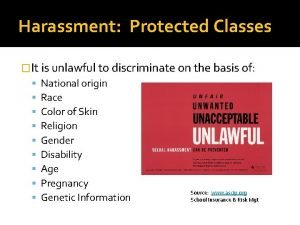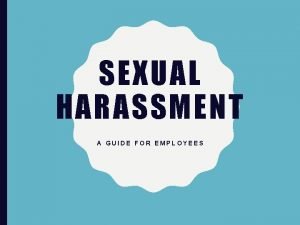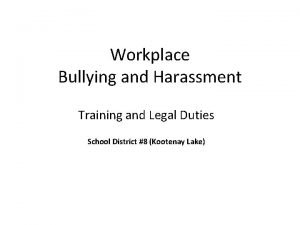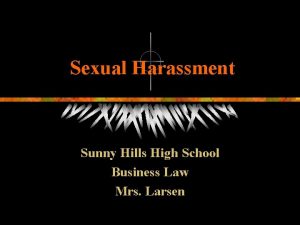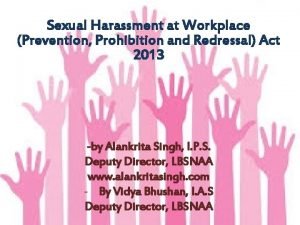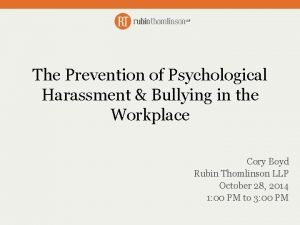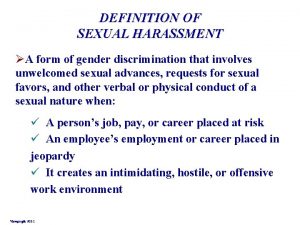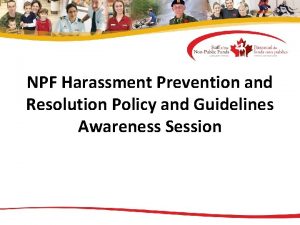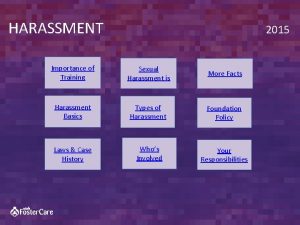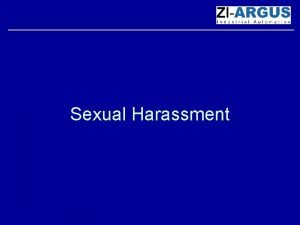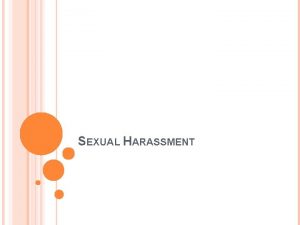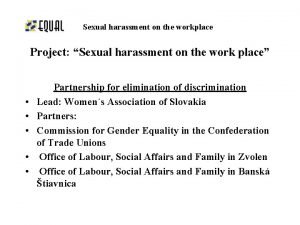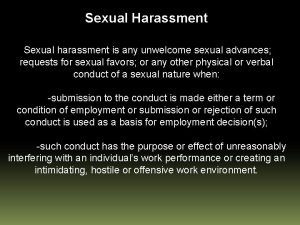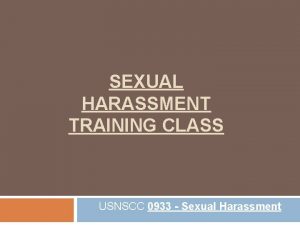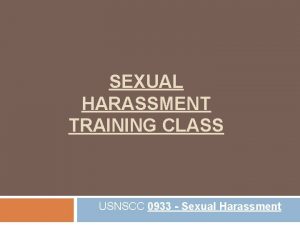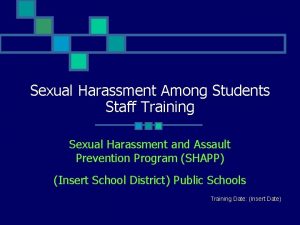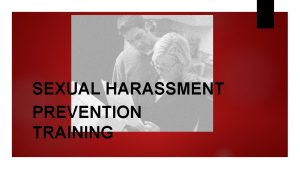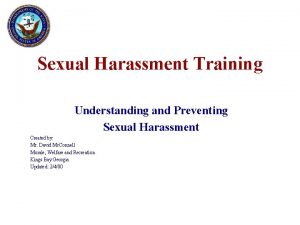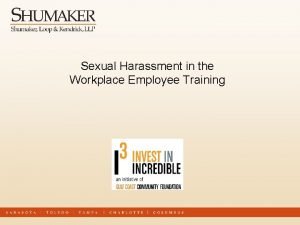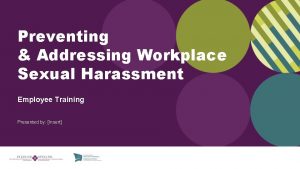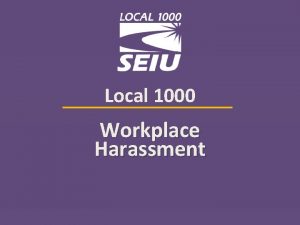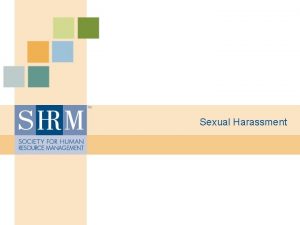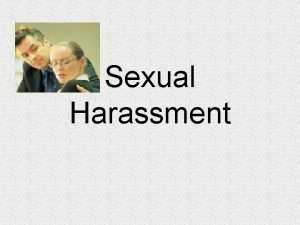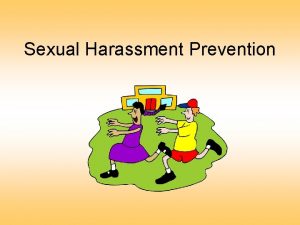Sexual Harassment in the Workplace Employee Training Introduction



























- Slides: 27

Sexual Harassment in the Workplace Employee Training

Introduction • define the types of conduct that may constitute sexual harassment; • breakdown of the policy • make you aware of your obligations as an employee to avoid engaging in inappropriate conduct and to report if you are aware that such conduct may be occurring.

Introduction • I am using the legal standard to explain - BUT - don’t just be worried about a lawsuit. • If you behave inappropriately: – You can be sued-personally ($$) – You can get your employer sued ($$) – You will be embarrassed – You can lose your job, get demoted etc. – Your family will find out

Our policy “The company expressly prohibits any form of unlawful harassment based on race, color, religion, sex, national origin, age, disability, status as a veteran, or status in any group protected by state or local law. ”

Definition • Sexual harassment is defined as: • sexual advances; • requests for sexual favors; or • other verbal or physical conduct of a sexual nature that affects a term or condition of employment.

Who can inflict? • Harasser can be an employee, supervisor in another area, co-worker, non-employee, subordinate, customer, member • The victim does not have to be the person harassed so long as the victim is affected by the offensive conduct • Can be same sex or opposite sex harassment • Victim can be male or female • Harasser can be male or female

TWO TYPES OF SEXUAL HARASSMENT • QUID PRO QUO HARASSMENT • HOSTILE WORK ENVIRONMENT

Quid Pro Quo Harassment – When a work-related benefit is conditioned expressly or impliedly on a sexual favor. • Ex. Spend the night with me and I will promote you. – This can also occur when the employee is penalized for refusing. • Ex. Spend the night with me or you will be fired. – Must involve a tangible benefit: hiring, failure to promote, reassignment with different duties, significant change in benefits, etc.

Hostile Work Environment • • Unwelcome verbal or physical contact of a sexual nature which alters the conditions of employment. The reporting person must find the conduct hostile, abusive, or offensive Does not require a tangible job benefit or detriment Can involve more than sexual hostile work environments (i. e. other protected classes) – Ex. Racially hostile work environment – Ex. Religious hostile work environment

Hostile Work Environment Elements: – Belongs to a protected class – Subjected to unwelcome harassment – Harassment was based upon a protected characteristic – Sufficiently severe or pervasive to alter the terms and conditions of employment and create a discriminately abusive work environment

EXAMPLES OF TYPES OF HARASSMENT • • • Verbal – Examples: Offensive comments, jokes, off-color remarks, comments about another’s anatomy or body parts or one’s own, discussion of own or other’s sex life, catcalls or whistling. Visual – Examples: Offensive gestures, staring, leering, offcolor cartoons, drawings or photos, offensive or offcolor email messages or faxes, graffiti, displays of pornography or attempting to show pornography to others, exchange of sexual “gag” gifts, off-color screen savers or posters. Tactile – Examples: unwanted touching including back or shoulder rubs, groping, brushing up against someone, attempting to sit on someone’s lap, hugs, trying to kiss someone, patting, pinching.

• * The key is that to be unlawful, the conduct must be offensive and/or unwelcome to the victim. • The intent of the harasser is absolutely irrelevant to a determination whether the conduct was offensive or unwanted. – Why? In the law’s view, it’s all about the perception of the victim.

Perspective of the reporting person • The conduct is unwelcome if the reporting person regards it as undesirable or offensive. • The conduct may be unwelcome even if the reporting person “voluntarily” submits to it. • Generally it requires communication that the conduct is unwelcome, although the repeated failure to respond to consistent comments and gestures can be sufficient.

Reasonable person of the same gender • More common statistically for men to harass women • For this reason some courts have adopted a “reasonable woman” standard – Conduct many men find unobjectionable may offend women

Our policy With respect to sexual harassment, The Company prohibits the following: 1) Unwelcome sexual advances, request for sexual favors, and all other verbal or physical conduct of a sexual or otherwise offensive nature, especially where: – Submission to such conduct is made either explicitly or implicitly a term or condition of employment – Submission or rejection of such conduct is used as the basis for decisions affecting individual’s employment; or – Such conduct has the purpose or effect of creating an intimidating, hostile, or offensive work environment

Our policy With respect to sexual harassment, The Company prohibits the following: 2) Offensive language, jokes, gestures, innuendos, comments, and other sexually oriented statements as well as pictures, calendars, graffiti, or objects

Our policy With respect to other forms of harassing behavior, The Company prohibits any behavior that can create an offensive work environment including, but not limited to: 1) Unwelcome and unwanted advances that are intentional or repeated 2) Behavior that is harmful to employees and employers -Statements or actions that could be interpreted as racially, sexually, religiously, or ethnically based -Any behavior, whether physical or verbal that intimidates, insults, demeans, or is hostile to the recipient. -Any treatment of employees in which submission to such conduct is implicitly or explicitly made a term or condition of employment.

• How do you know if someone is offended or your conduct is unwelcome? – You don’t - just because someone seems to find conduct welcome or does not appear to be offended doesn’t mean it is safe to assume that they aren’t. – The law does not require a plaintiff in a harassment suit to confront the harasser or tell the harasser that their conduct is unwanted or offensive.

• What is safe to say/do with respect to your conduct in the workplace? – Litmus test No. 1: Would I want someone to say/do it to my wife, daughter, grandmother? – Litmus test No. 2: Would I say/do it if my wife, daughter, mother was standing there?

Our policy “If you experience any job-related harassment based on your sex, race, national origin, disability or other factor protected under Title VII, or believe you have been treated in an unlawful discriminatory manner, promptly report the incident directly to the Human Resources Department who will undertake an investigation within 5 days of filing of the complaint. ”

Our policy “If you feel that for any reason you need to report to someone other than the local management, you may contact the Vice President of Human Resources at_________. ”

Our policy “The employee should make the complaint as soon as possible after the alleged incident without fear of retaliation. Your complaint and all investigation records of harassment will be confidential and will be kept confidential to the maximum extent possible. ”

Your obligations • Obligation as an employee: – to avoid inappropriate conduct and – report if you are aware such conduct is occurring

Your obligations • Who do I report it to? – A Supervisor; or – Administrator

Your obligations • YOU WILL NOT BE PENALIZED IN ANY WAY FOR REPORTING SUCH IMPROPER CONDUCT

Work together • We cannot help if we do not know there is a problem – do not assume that the company is aware of the problem. – Report promptly so the issue can be immediately addressed before it reoccurs. – Be specific when reporting to ensure management understands. – Tell the harasser to stop – if you feel comfortable doing so.

Work together • If we work together we can make sure we have a work environment free of discrimination and unlawful harassment.
 Sexual harassment at workplace act nepal
Sexual harassment at workplace act nepal Bullying and harassment training resources
Bullying and harassment training resources Louisiana sexual harassment training
Louisiana sexual harassment training Sexual harassment training quiz
Sexual harassment training quiz Wsu sexual harassment training
Wsu sexual harassment training Workplace harassment oregon
Workplace harassment oregon Workplace violence and harassment quiz answers
Workplace violence and harassment quiz answers Objective of sexual harassment
Objective of sexual harassment Anime genitals
Anime genitals Sexual harassment seminar
Sexual harassment seminar Sexual harassment objectives
Sexual harassment objectives What is harassment
What is harassment Sexual harassment cases in correctional centres
Sexual harassment cases in correctional centres Sexual harassment is not a joke
Sexual harassment is not a joke Sexual harassment definition
Sexual harassment definition Offensive language in the workplace
Offensive language in the workplace Bullying and harassment training presentation
Bullying and harassment training presentation Introduction to employee training and development
Introduction to employee training and development Employee attitudes and employee performance
Employee attitudes and employee performance Sexual harrasment prevention training
Sexual harrasment prevention training Sexual abuse quiz
Sexual abuse quiz Psychological harassment
Psychological harassment Definition of gender harassment
Definition of gender harassment Policy on harassment prevention and resolution
Policy on harassment prevention and resolution Landlord and tenant edmonton
Landlord and tenant edmonton Harassment status
Harassment status Framework agreement on harassment and violence at work
Framework agreement on harassment and violence at work Sexual
Sexual






